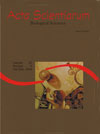Host-parasite relationship in fish from fish farms in the Assis region, São Paulo State, Brazil. 1. <em>Oreochromis niloticus</em> (Linnaeus, 1757)
Abstract
A total of ninety specimens of Oreochromis niloticus were collected every other month between February and December of 2004 at three fish farms in São Paulo State. 82.2% were parasitized by at least one species of parasite. Physical and chemical water parameters were used to characterize water quality in each fish farm. Seven species of ectoparasites were registered. It was possible to observe that all fish farms presented the same parasite fauna; however, each farm featured its own peculiar community structure. Cichlidogyrus sclerosus and Cichlidogyrus sp.1 presented a significant negative correlation of abundance to standard host length only at the Palmital fish farm. The Cichlidogyrus sp. 2 species and the Lamproglena sp. copepod displayed a significant positive correlation of abundance to standard length at the Tarumã and Cândido Mota fish farms, respectively. With regard to the relative condition factor, only the species Cichlidogyrus sp. 1 presented a significant negative correlation to the prevalence of parasitism. Lamproglena sp. presented a significant positive correlation with respect to the hepatosomatic index (HI) of the tilapias at the Palmital fish farm, and the Ergasilidae presented a significant negative correlation of abundance with respect to splenosomatic index (SI) of the host at Cândido Mota.Downloads
Download data is not yet available.
Published
2007-12-17
How to Cite
Lizama, M. de L. A. P., Takemoto, R. M., Ranzani-Paiva, M. J. T., Ayroza, L. M. da S., & Pavanelli, G. C. (2007). Host-parasite relationship in fish from fish farms in the Assis region, São Paulo State, Brazil. 1. <em>Oreochromis niloticus</em> (Linnaeus, 1757). Acta Scientiarum. Biological Sciences, 29(2), 223-231. https://doi.org/10.4025/actascibiolsci.v29i2.594
Issue
Section
Parasitology
DECLARATION OF ORIGINALITY AND COPYRIGHTS
I Declare that current article is original and has not been submitted for publication, in part or in whole, to any other national or international journal.
The copyrights belong exclusively to the authors. Published content is licensed under Creative Commons Attribution 4.0 (CC BY 4.0) guidelines, which allows sharing (copy and distribution of the material in any medium or format) and adaptation (remix, transform, and build upon the material) for any purpose, even commercially, under the terms of attribution.
Read this link for further information on how to use CC BY 4.0 properly.
0.6
2019CiteScore
31st percentile
Powered by 

0.6
2019CiteScore
31st percentile
Powered by 











1.png)




3.png)













